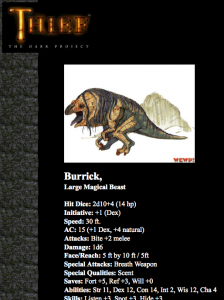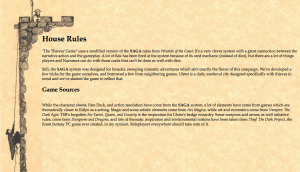Seriously, I could write a book on those Thief games. Yesterday, in issue 205: Parting the Digital Sea, The Escapist published my all-too-short article, “Robbing Gods,” which just scratches the surface of the game’s world-building by looking at how it uses religion to frame us, the player, as mobile outsiders while simultaneously using it to define a rich, nuanced world for us to explore. Go and read that, and please do leave a comment over there if you have one — these kinds of articles are sometimes measured by the extent that they’ve provoked the audience, I think.
Click through for the complete notes on the Thief-inspired RPG campaign I ran in 1999.
If you’ve clicked over here from The Escapist, here’s a look at those d20 System stats for the Burrick I made. I make no claim to their worth, only their existence. This was rediscovered online, along with my old Thief fan page, sadly.
To demonstrate just how influential Thief: The Dark Project and its descendants have been to my design style, I’m sharing with you one more look at my embarrassing past, left adrift online like the flotsam it is: The Thieves’ Game website.
Somehow, this thing is nearly intact in the ground, a decade-old archaeoludological artifact from a time before blogs, when I put stuff online like an idiot, for just a handful of people to reference. And of course I wrote it as if it were being viewed by people who didn’t play in the game with us every week. Lunacy.
Look at that site design. Whatever you have to say, my response is likely to be: “I know, right?”
Of no interest to you are the (amateur shitty) illustrations, exhaustive histories, treasure list, and thin coverage of the fantasy city of Ulster. Of potential interest to some of you, though, might be the page of house rules we used for the SAGA system, our game mechanics of choice at the time. (Thus I can date this campaign to late 1999 and early 2000, as we switched to D&D, and a new campaign when 3rd Edition debuted in 2000.) “Thieves’ Game” was a lot of fun, very dramatic, with a really wonderful character-driven narrative unfolding from actual choices and consequences. I did almost no planning of story, only character goals and setting detail. This campaign taught me a lot about player freedom in closed environments.
It was also a corrosive, troubling experience, full of player-versus-player scheming and backstabbing. (This is, more or less, why we switched to D&D so quickly.) Some of that skullduggery spilled outside of the game sessions into metagame exploits meant to build tension or sway player choices. The players, in a sense, slipped outside the boundaries of normal player limits and stole portions of the Narrator’s role — all of this in ways that would be old hat now, with shared-authority indie RPGs, but it was a little troublesome then.
Players were keeping secrets from each other, lying for their characters about the location of stolen goods and what characters (both PCs and NPCs) knew about the PCs’ plans. This culminated in a secret plot hatched by half of the PCs to get one of their supposed comrades caught or killed by a band of rival NPCs, because they discovered their comrade had been stealing from them. They planned that operation for weeks, whispering over midnight tacos when the game was supposedly done for the night.
Oh, and the characters were all brothers. It was a great game.
Anyway, when I found this online, I thought it might work as a kind of Portrait of the Writer As A Young Man. But, yeah, it doesn’t so much.



Oh, I don’t have the words for it, but thanks for posting this. I immediately thought of the Thieves’ Game after you posted the info about another Thief. I loved that game, and Rorrick, even as they were heartbreaking in the end.
Any chance you also have any Strange Legion or Edlyn materials sitting around on the internets?
I have very little from those days left anywhere, unfortunately. I have a HD that predates it, and data that postdates it, but I’m missing a lot of material. My experience is that the notes seldom live up to the memories, anyway.
Except the campaign journal Serena made for Meridian. That thing’s awesome.
I did a GURPS: The Dark Project game, it went well as soon as we all realized we were fundamentally playing a noir game. That’s when the non-thief characters came into their own from that setting (a broadside newspaperman, a torch singer and secret Pagan, and a sleazy fence who was formerly a sex-slaver until an attack of conscience).
I did another game set in a proto-18th century version of the Thief setting, with revolutionary ideals springing up and the characters were Keepers. I used the Marvel Universe RPG for it since Keepers are basically creepy-magic stealth superheros. Worked like a charm.
Naturally there is much there for an organized crime game as well…
But never, ever knock out Ramirez. Leave every person in his house unconscious on the front lawn, and steal everything not nailed down, but make absolutely sure he stays wandering around in his basement forever.
Hit the alarm on your way out for good measure.
The site where I once had my old mage game’s webpage is long gone, but I’ve never quite been able to bring myself to delete the saved html files from my docs folder. I actually opened them up just now, and the nostalgia has me grinning.
Althoug, I’d never criticize that site design — it’s far, far prettier than my wall o’text pages and really bad MS Paint icon!
Isn’t it great, Jason, to see how many different systems a setting can actually support? I’ve twice, now, had books (in two different systems) meant to evoke a Thief style of play go into early development only to be brought down by the vagaries of development hell.
Finding the right mechanisms for play depend a lot on what the individual campaign is meant to be about. For sure Thief is noirish — Thief II is frankly noir, right down to the villain being named for the zither-master who composed the score for The Third Man — but the setting is such a curious hodgepodge of the medieval (in its cosmology and some of its culture), the Victorian (in art styles and mannerisms), the art-deco Mechanists, and the various historically inspired fantasy elements of the Precursors through to the third game’s Fish-People.
That one city is home to Bafford’s stylized medieval manor and the second game’s Victorian warehouse district (complete with Bobby-ish bulldogs) without being pulled apart is pretty remarkable. We say steampunk, but that doesn’t capture the nuance of it all. There’s lots of play left in The City, in my opinion.
Lauren, if those HTML files still work, think about burning the site onto a disc — you should be able to send the thing to your players as a simple keepsake, then. The site should run right off the disc. I did for this thieving campaign back when and it helped us feel like we had made something fun — and finished it.
I second the disc idea. I was just talking to one of the other players (Marty,) and we both still have our copies. It isn’t simply a memento. It is also a sort of trophy. In fact, that would be a whole other post: keepsakes from games past.
Our Thieves game ran into Strange Legion, the gold standard upon which I judge all subsequent RP. I still remember our last session, when Owen is turned to stone. Owen is the basis for two other characters–one game failed,the other is still going strong–and Edlyn is the setting I wish I could have thought of.
While Strange Legion let us design our own part of the game world, Edlyn was the realm where we got to focus on our characters and their relationships.
There would be no Strange Legion without your tribute to Thief. Without Strange Legion, there would be no Trek Game, no Epic and probably no Bricu (WoW).
While Thief was one of the games I wanted to play (but never could do to OS constraints), I don’t think I missed out on it. The Brothers Sharpsbury and Edlyn more than made up for it.